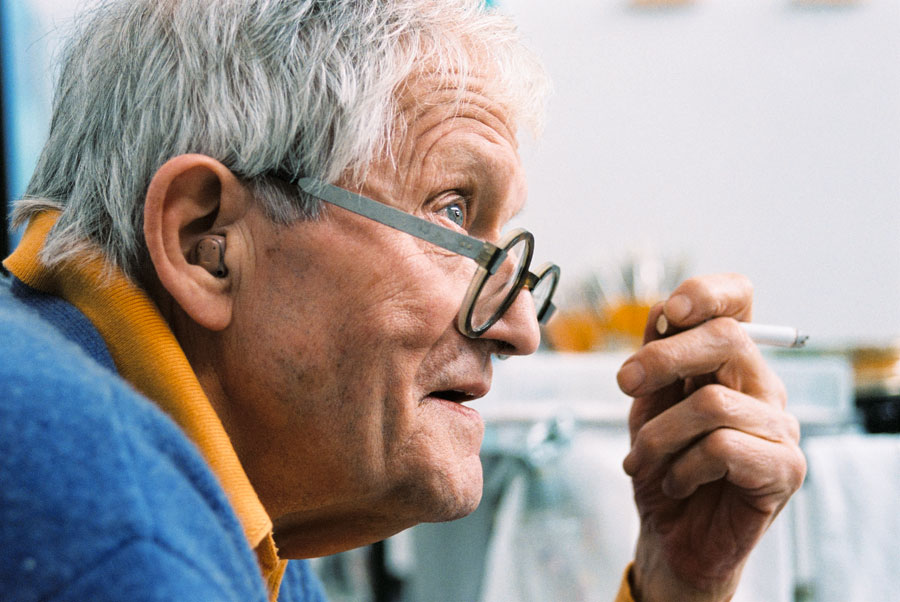Critic's Guide: West End Night
The tale of a legendary pilot and a portrait of David Hockney: what to see tonight
The tale of a legendary pilot and a portrait of David Hockney: what to see tonight

For the complete list of the galleries participating in this year’s West End Night (6 October, 6 – 8pm) click here.

Akram Zataari
Thomas Dane Gallery
23 September – 5 November
We all grow up with tales of heroes, villains and local legends. Here’s one that Lebanese-born artist Akram Zataari remembers being told as a boy: In 1982, during the Israeli occupation of Southern Lebanon, an Israeli fighter pilot was ordered destroy a municipal building on the outskirts of Saida. Upon approaching the target, he realized that the building was a school and dropped his bombs into the ocean instead of destroying it. Decades after hearing this tale, Zaatari met with the filmmaker Avi Mograbi, recounting the act of defiant heroism once more. It was only after this transcript was published that he discovered the pilot was real. His name was Hagai Tamir.
Letter to a Refusing Pilot (2013), a peaceful, contemplative video first shown at the 55th Venice Biennale and the centrepiece of Thomas Dane’s current exhibition, takes Tamir’s empathetic objection as its centre point, making use of local footage, aerial photographs and drawings in order to reconstruct this character and the event. To borrow Zaatari’s own words: in times of war, it is important to follow Tamir’s lead and remember that everyone is a human being.

Peter Saul
Michael Werner
23 September – 5 November
Peter Saul’s first London exhibition is titled ‘Some Terrible Problems’. But with titles like Superman and the Super Dogs Find God in the Asteroid Belt, Cowboy’s Last Drink? and Chinese Cubist; Art Appreciation you might be tempted to think he’s forgotten to insert the qualifier ‘first world’. Saul makes vast, garish, ludicrous cartoon smothered canvases. Take Abstract Expressionist Still Life: here, two supposedly diametrically opposed painterly styles are united in a sweeping deluge of car bumpers, oranges, feet, wine glasses and a leather seat supporting a block of cheese. The painting is obscene, mismatched and hilarious. But as Saul blasphemes with each of his subjects: who cares?

Tacita Dean
Frith Street Gallery
16 September – 4 November
I can’t decide whether Tacita Dean’s latest series of lithographs fills me with sweet nostalgia or seething jealousy. Made in collaboration with legendary printmakers Gemini G.E.L., who have previously worked alongside the likes of David Hockney, Man Ray and Richard Serra, the works capture the cerulean blue of the LA sky, calmly intersected by the vapour trails of anonymous planes – the floating memory of presence. Breaking the serenity of the room is the bleeding sound of Dean’s film Event for a Stage, Dean’s first foray into the world of theatre, but the real treat lies in the basement, where a new 16mm film Portraits (2016) flickers away in the darkness. The work, an unassuming 16 minutes in length and also shot in LA, focuses on a 79-year-old David Hockney who sits, yellow-shirted, blue-jumpered, round spectacles-adorned. The reverence Dean has for Hockney is clear. She asks nothing of him, and he does nothing in return. Just sits, smokes, and breathes, the smoke recalling the vapour trails above – the memory of presence.

Helen Marten
Serpentine Gallery
29 September – 20 November
In a recent review of Tate Britain’s exhibition of Turner Prize nominees, Adrian Searle wrote that Helen Marten’s sculptures ‘somehow collide and talk to one another in such a way that you can’t tell the detail from the main event.’ Nowhere is this more clear than in her latest exhibition at Serpentine, ‘Drunk Brown House’. Upon entering, you find yourself in a hoarder’s paradise: lemons are stuck with nails, crabs are assembled from cans, washing lines are hung with creepy feet cut from thick felt. There is little rhyme here, an almost complete lack of reason, yet through an artful control of colour (blues, crèmes, silvers), texture (a distinctive matt paint) and a stunning attention to detail, everything seems symbiotically connected.

Basel Abbas and Ruanne Abou-Rahme
Carroll/Fletcher
9 September – 29 October
Basel Abbas and Ruanne Abou-Rahme’s immersive project And yet my mask is powerful (2016) takes its lead from a poem by Adrienne Rich, ‘Diving into the Wreck’, written in 1971-72. The poem recounts a solo scuba dive to a shipwreck, made in order to witness the real, not the retold: ‘the wreck and not the story of the wreck’.
For this project, Abbas and Abou-Rahme apply this same exploratory thinking, returning to sites of destruction and subsequent erasure in Palestine (the wreck) in order to imagine possible narratives that are divergent from those ordinarily circulated (the story). At Carroll/Fletcher, clear plastic bags display titbits claimed from the sites (bottle caps, twine, sweet wrappers), dried samples of plants protrude from bricks, and a video shows the pair wandering through trees, their faces concealed behind 3D-prints of Neolithic masks that were looted from the West Bank and now sit in Israeli museums. It’s a strange, curiously ominous exploded history, one that can be reassembled and dissembled as the viewer sees fit. Upon visiting sites like these, says Ruanne, ‘you’re witnessing your own erasure’.
For the complete list of the galleries participating in this year’s West End Night (6 October, 6 – 8 pm) click here.






















